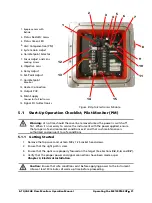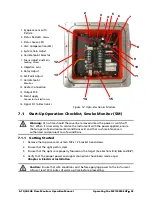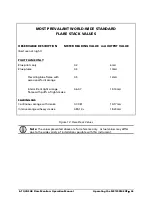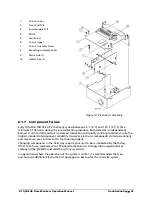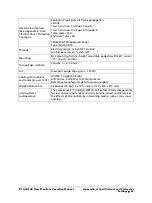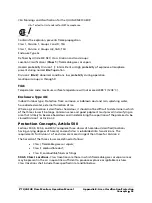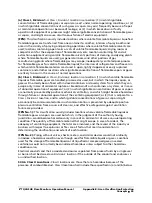
E
2
T QUASAR Flare Monitors Operation Manual
Operating the M8100SM-EXP
•
44
7.1.2
Initial Control Settings
(Item numbers refer to Figure 13)
1.
Adjust all Pots to full counterclockwise (Items 5, 9, 10).
2.
Set the Climatic Compensation Selector Switch (Item 4) at 200X.
3.
Move the Gain/Setpoint Switch (Item 6) to the Setpoint position.
4.
Verify the Setpoint Adjust Pot (Item 10) is set for 0.7 on analog meter (Item11).
5.
Set the Gain/Setpoint Switch (Item 6) to Gain position after step 4 is accomplished.
Note:
When powered up, the instrument will show a Green LED on even when no
signal is present.
7.1.3
System Gain/Climate Compensation
A normal operating condition is defined as the condition in which the flame will be operating
nominally where any more intense orange flame or smoke would indicate an upset condition.
System gain is set under this nominal condition such that the instrument reads mid-scale.
While operating the Flame Stack during normal conditions, aim the instrument at the flame on
the top of the stack (Figure 12). Adjust the System Gain Pot (item 5) for a peak reading of
approximately 0.5 (mid-scale) on the analog meter. Place your hand over the Objective lens. The
analog meter should drop to slightly above zero.
Note:
If the Flame ‘normal’ operating conditions are not achievable for this
adjustment, refer to the Flame Description Note at the end of this procedure.
7.1.4
Set-point
The System Gain setup (section 7.1.3) established a reference point of .5 on the analog meter for
normal operational conditions. If .5 is the acceptable condition, the operator must determine
the reference point on the meter where an unacceptable condition is present, thus triggering an
alarm condition.
The Set point adjustment sets the reference point for this alarm condition. A typical setting of
0.7 on the meter was set in step 4 of
Section 7.1.2
, if this is acceptable, then nothing needs to
be done. If this is not acceptable, then repeat steps 3 thru 5 ONLY to adjust to desired level.
7.1.5
Relay Contacts
The Instrument can provide to the control room a separate ‘loss of signal’ alarm through relay
dry contacts which indicates a smoke condition.
Check the relay contacts at the instrument’s Terminal Output board TB2. Relay N.O. and Relay
N.C. contacts are available simultaneously. Verify that the desired polarity is observed during an
alarm condition. Note the Relay contact position when the instrument power is interrupted or
shut-off.


